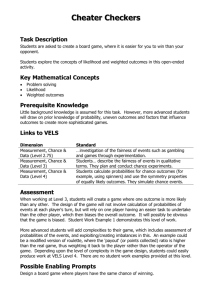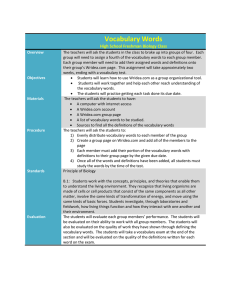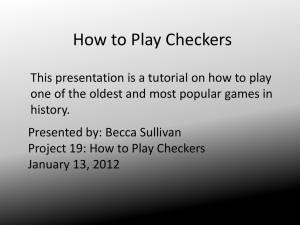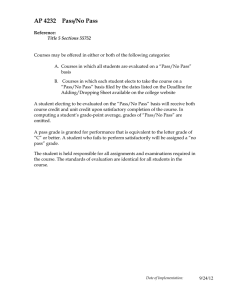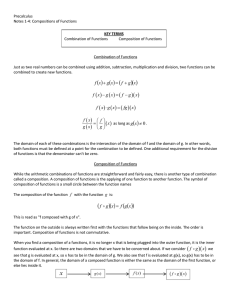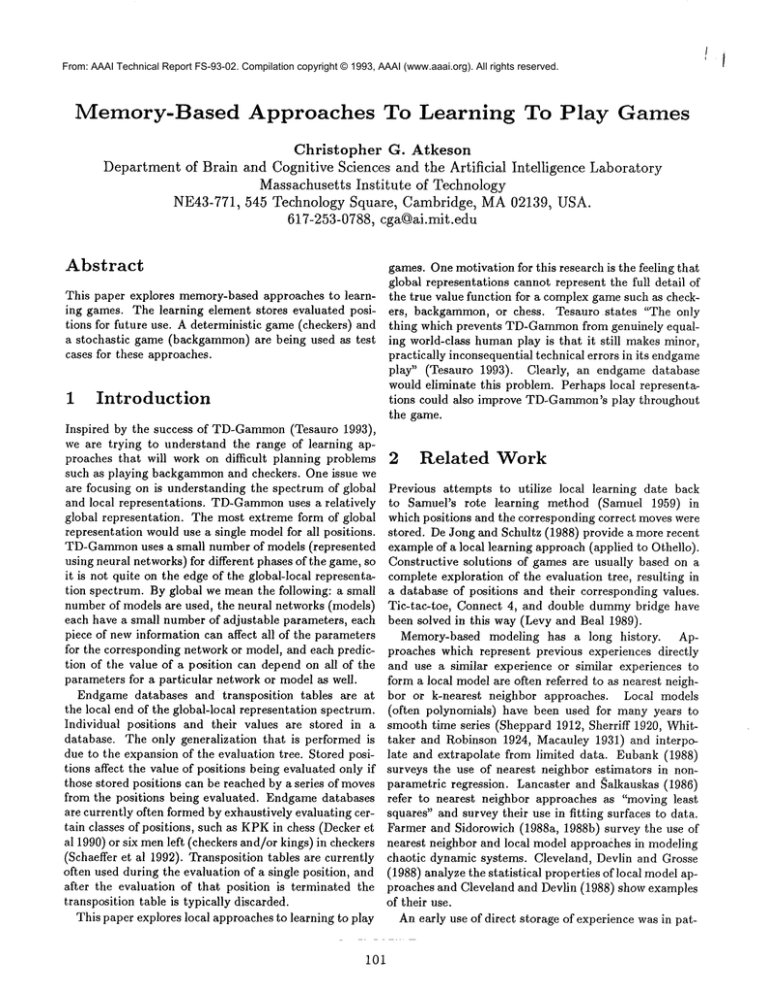
From: AAAI Technical Report FS-93-02. Compilation copyright © 1993, AAAI (www.aaai.org). All rights reserved.
Memory-Based
Approaches
To Learning
To Play
Games
Christopher
G. Atkeson
Department of Brain and Cognitive Sciences and the Artificial
Intelligence
Laboratory
Massachusetts
Institute
of Technology
NE43-771,545
Technology
Square,
Cambridge,
MA 02139, USA.
617-253-0788,
cga@ai.mit.edu
Abstract
games. One motivation for this research is the feeling that
global representations cannot represent the full detail of
This paper explores memory-based approaches to learnthe true value function for a complex game such as checking games. The learning element stores evaluated posi- ers, backgammon, or chess. Tesauro states "The only
tions for future use. A deterministic game (checkers) and thing which prevents TD-Gammon
from genuinely equala stochastic game (backgammon) are being used as test
ing world-class humanplay is that it still makes minor,
cases for these approaches.
practically inconsequential technical errors in its endgame
play" (Tesauro 1993). Clearly, an endgame database
would eliminate this problem. Perhaps local representations could also improve TD-Gammon’splay throughout
1 Introduction
the game.
Inspired by the success of TD-Gammon
(Tesauro 1993),
we are trying to understand the range of learning approaches that will work on difficult planning problems 2
Related
Work
such as playing backgammonand checkers. One issue we
are focusing on is understanding the spectrum of global Previous attempts to utilize local learning date back
and local representations.
TD-Gammon
uses a relatively
to Samuel’s rote learning method (Samuel 1959)
global representation. The most extreme form of global which positions and the corresponding correct moves were
representation would use a single modelfor all positions. stored. De 3ong and Schultz (1988) provide a more recent
TD-Gammon
uses a small number of models (represented
example of a local learning approach (applied to Othello).
using neural networks) for different phases of the game, so Constructive solutions of games are usually based on a
it is not quite on the edge of the global-local representa- complete exploration of the evaluation tree, resulting in
tion spectrum. By global we mean the following: a small a database of positions and their corresponding values.
Connect 4, and double dummybridge have
number of models are used, the neural networks (models) Tic-tac-toe,
each have a small number of adjustable parameters, each been solved in this way (Levy and Beal 1989).
piece of new information can affect all of the parameters
Memory-based modeling has a long history.
Apfor the corresponding network or model, and each predic- proaches which represent previous experiences directly
tion of the value of a position can depend on all of the and use a similar experience or similar experiences to
parameters for a particular network or model as well.
form a local model are often referred to as nearest neighEndgame databases and transposition
tables are at bor or k-nearest neighbor approaches. Local models
the local end of the global-local representation spectrum. (often polynomials) have been used for many years
Individual positions and their values are stored in a smooth time series (Sheppard 1912, Sherriff 1920, Whitdatabase. The only generalization that is performed is taker and Robinson 1924, Macauley 1931) and interpodue to the expansion of the evaluation tree. Stored posi- late and extrapolate from limited data. Eubank (1988)
tions affect the value of positions being evaluated only if surveys the use of nearest neighbor estimators in nonthose stored positions can be reached by a series of moves parametric regression. Lancaster and ~alkauskas (1986)
from the positions being evaluated. Endgamedatabases refer to nearest neighbor approaches as "moving least
are currently often formed by exhaustively evaluating cer- squares" and survey their use in fitting surfaces to data.
tain classes of positions, such as KPKin chess (Decker et Farmer and Sidorowich (1988a, 1988b) survey the use
a11990) or six menleft (checkers and/or kings) in checkers nearest neighbor and local model approaches in modeling
(Schaeffer et al 1992). Transposition tables are currently chaotic dynamic systems. Cleveland, Devlin and Grosse
often used during the evaluation of a single position, and (1988) analyze the statistical properties of local modelapafter the evaluation of that position is terminated the proaches and Cleveland and Devlin (1988) show examples
transposition table is typically discarded.
of their use.
This paper explores local approaches to learning to play
An early use of direct storage of experience was in pat101
tern recognition (surveyed by Dasarathy (1991)). Fix
Hodges (1951, 1952) suggested that a new pattern could
be classified by searching for similar patterns amonga set
of stored patterns, and using the categories of the similar patterns to classify the new pattern. Steinbuch and
Taylor proposed a neural network implementation of the
direct storage of experience and nearest-neighbor search
process for pattern recognition (Steinbuch 1961, Taylor
1959), and pointed out that this approach could be used
for control (Steinbuch and Piske 1963). Stanfill and Waltz
(1986) coined the term memory-based and proposed using
directly stored experience to learn pronunciation, using
a Connection Machine and parallel search to find relevant experience. They have also applied their approach
to medical diagnosis (Waltz 1987) and protein structure
prediction. Aha et al (1991) describe related approaches.
3
Issues
Learning
In
Memory-Based
One way to envision the issues involved in a local learning
approach is to ask what would happen if a transposition
table was maintained as a permanent database? How
could one guarantee that the stored evaluations were always improved, if the evaluations were based on a limited depth search guided by changing heuristics and approximate evaluation functions? Howcan we decide what
to remember and what to forget, given limited memory
resources? Howfar should one extrapolate values from
stored positions to predict values for similar positions?
What distance metric should be used to compute similarity? Whatare the interactions and tradeoffs between generalization based on similarity and generalization based
on the evaluation tree?
Given the range of design choices in designing a local
learning approach to games, we have decided to explore
the global-local spectrum starting at the far edge of the
local end. Values for specific positions are remembered,
only exact values are stored, and no generalization based
on similarity is used. More "globalness" will be incorporated as the local learning algorithms reach performance
limits or we run out of memoryor computer time. Various forms of similarity based generalization will then be
explored.
Another research approach we could have taken would
be to start with a successful global approach such as TDGammon
and add corrections to its representation of the
value function using additional local representations. One
could "correct" movechoices or values of positions not accurately generated by the global representation. Wehave
not pursued this route, although it is a very reasonable
approach to take. Wealso note that a large database of
evaluated positions is an excellent addition to the training set for a global learning approach, and can also be
used for discovering or selecting features to be used in
heuristic evaluation functions.
To dispell fears that a local approach is hopeless due
~02
to the number of positions that need to be stored, let
us crudely calculate the number of stored evaluated positions needed to force a 1 ply evaluator to follow the
optimal game path. Let us initially assume we have a cooperative opponent who always chooses an optimal move
and that for each set of possible movesthere is a single
best move. In that case each player chooses between B
moves (B being the branching factor) at each point in
deterministic game. If the game lasts for L moves, the
number of moves evaluated and positions looked up in
the database is BL. If there are Wbest moves with the
L positions need
same value at each position then BLW
to be stored. A player can resolve the choice between its
best movesin a fixed way, but it is unlikely the opponent
will be that cooperative, so this estimate can be reduced
to BLWL/2. If there is a random element before each
move(such as R possible outcomes of a roll of the dice)
then an estimate of the number of positions that need to
be stored is L.
BLR
All of these estimates assume the opponent is 1) unaware of the limited memory of the player, and 2) an
optimal player. Neither of these assumptions may be
true. However, for the opponent to change the path of
the game, the opponent must make a non-optimal move
(or a sequence of non-optimal moves). The amount that
these moves are non-optimal is controlled by the coverage of the database. A value threshold can be chosen to
determine which suboptimal game paths are also stored.
If we assume a fixed distribution of movevalues from any
position, the threshold will select T moves at each position to be explored, leading to BLTL/2 positions looked
up in the database. If the opponent succeeds in moving
the game outside the expertise of the database, we expect a more global representation
such as TD-Gammon
to be able to take advantage of the non-optimal opponent
moves.
Given the exponential dependence of someof these estimates on the length of the game remaining, it may be the
case that local learning will be most useful in midgames
and endgames(local representations are already successful in manyendgnmesin checkers and chess). It is also important to keep in mind that a powerful search algorithm
similar to what is currently used in chess and checkers
will be used in combination with the position database.
(Current backgammonprograms search 2 ply, our program based on a local representation routinely searches
up to 8 ply in endgamepositions). This may dramatically
reduce the numberof positions that need to be stored for
expert play (Schaeffer et al 1992 hope to solve checkers by
combining an endgame database with powerful search).
Local learning approaches may still be hopeless, however, when one considers the amount of computation
needed to find and evaluate the positions along the optimal game paths that will be stored in the final database.
Here, we make use of the same trick used in many global
learning programs. Weonly "train" on positions seen in
actual games and positions explored during the evaluation of those game positions. This approach allows us to
take advantage of expert play by humanor computer, and
focus attention and memoryresources on positions that
occur during expert play. Weare no longer representing
optimal game paths, but only expert game paths.
Weuse additional tricks to limit the number of positions that are stored. If a function that bounds the value
of an unevaluated position is available, these bounds can
be used to eliminate this position from consideration in
the database building process. Any heuristic evaluator
can be used to guide game tree search to minimize the
number of positions stored in a similar way to how the
alpha-beta algorithm allows us to ignore portions of a
evaluation tree. So far, we have stored all evaluated positions. In the future we plan to store only the positions
resulting from best moves (the best of all legal moves
from a given position). Wehope to use the technology of
limited rationality (Russell and Wefald 1991, Banmand
Smith 1993) to help decide what is worth computing, and
what is worth remembering. Schaeffer et al (1992) point
out that it is sometimes cheaper to run length encode
a complete database for a class of positions rather than
to encode a limited number of positions from the same
class, even when the sparse database represents the errors of a parametric evaluation function fit to the complete database. Wedo not expect this to be generally
true, but we will use exhaustive databases for classes of
positions which can be compactly represented in this way.
4
A 4x4 checkers
nent would have had to make a losing move. In this simple
example there is almost a square root reduction from the
size of an exhaustive database (10,836 positions) to the
size of the database needed for an optimal player (on the
order of 100 positions). It is an empirical question as to
whether this kind of reduction will hold for more complex
games.
5
game
As a simple initial example we explored a 4x4 checkers
game, with each side having two pieces. Considering the
possibility that pieces can be promotedto kings, there are
10,836 possible positions. Wefully evaluated the starting
position, using a minimax value propagation algorithm.
Simple pruning algorithms of the following form were used
to restrict the search. If a moveto a winning position is
found, then the value of the initial position is a win, that
of the parent position is a loss, and no further evaluation of that parent position or its descendents need be
done. The search was terminated when no new positions
were generated by any moves from any positions. 3133
positions were evaluated in the complete game tree, 1706
of these positions were unique, and the search reached a
depth of 36 ply.
Weconstructed an optimal player using a local representation. The optimal player used a 1 ply evaluator, and
the storage control strategy was that the optimal player
used a fixed choice of movesso that only one of the best
moves had to be stored, while the opponent could choose
from any of its best moves, so that all the best opponent
moves had to be stored. In the case where the optimal
player movedfirst, the values of 111 positions had to be
stored in the local representation.
This number would
have been reduced if the value of the game was a win or a
loss rather than a draw. In any event, for the opponent to
guide play out of the database of 111 positions, the oppo-
103
An endgame
backgammon
database
for
Weare in the process of generating an endgamedatabase
for backgammon.Weare currently focusing on positions
in which both players are bearing off (2,944,473,169 possible positions). Candidate positions to be included in
the database are generated by self play using a linear
heuristic evaluation function, Tesanro’s pubeval (Tesauro,
personal communication). These positions are evaluated
using a minimax search with a fixed number of evaluations. Any position whose value is known exactly after
that search is stored. Approximate values for positions
are used to guide the search, and bounds on the values
of the positions are used to provide early cutoff. The
approximate and bounding values are propagated along
with the known values in the game tree. Approximate
values are derived by comparing the probability distributions of two players trying to independently minimize
the expected numberof rolls until their pieces are off the
board. This heuristic was taken from Berliner’s BKGprogram. Bounds on the value of a particular position were
taken in the following way. A worst case for a player is if
that player follows a suboptimal strategy, while the opponent plays a superoptimal strategy, and an upper bound
on the value of a position is provided by calculating the
expected outcome of a superoptimal strategy against a
suboptimal strategy. The probability distributions of the
numberof rolls until one player is off the board for each
of these strategies were compared to produce a bound on
the expected value of a position. The suboptimal strategy used was to minimize the expected number of rolls
until all pieces are off the board, independent of the other
players actions. The superoptimal strategy used was to
maximizethe probability of bearing all pieces off, knowing in advance the number of rolls left in the game. This
strategy is better than any optimal strategy, but it requires knowledgethat is not available during play. These
approximations and bounds can be applied to more general race positions, but it is not yet clear howto bound
the value of contact positions.
The position database is still being built, and we will
provide a crude evaluation of its performance here. Currently the database consists of 28,835,746 evaluated positions. No attempt has been made to prune this database
of unnecessary positions. A test set (not used in the construction of the database) of the first mutual bearoff positions encountered in games was generated. The test
set contained 327 positions. 127 of these positions could
.
be evaluated exactly using the bounds or using 1 ply
search. Without using the database, and using search
trees built using 50,000 position expansions (move generation and evaluation) 14 of the remaining positions were
evaluated to an exact value. Successful searches went as
deep as 8 ply, and unsuccessful searches went as deep as
17 ply. This measures the usefulness of the approximations and bounds described previously independently of
the database. Using the database, and reducing the number of position expansions to 10,000 resulted in 81 positions being evaluated to an exact value, in addition to the
127 immediate evaluations. Successful searches went as
deep as 8 ply, and unsuccessful searches went as deep as
14 ply.
6
Conclusions
In some ways the extremely local representational
approach we are taking is old, and in someways it is quite
new. Samuel used stored positions in 1959, and endgame
databases and transposition tables have been around a
long time. On the other hand, our goal is to store evaluated midgamepositions on a massive scale. Weare currently using 8 bytes to store a position and its value. Using this crude storage scheme 109 positions can be stored
on a $10,000 disk drive (or less). Weintend to combine
this with a search engine that is capable of searching 1
million positions/second. This will require the development of new search algorithms, as stored positions will
provide early cutoffs of portions of the search, and it may
be the case that directing the search towards areas of expertise (islands of knowledge) and away from positions
that are typically not in the database (seas of ignorance)
may be more useful than a completely forward driven
search. It is not clear how to optimally combine a heuristic evaluation function with this search process, or how
to optimally generate or learn an evaluation function using the information in the database. A large number of
empirical questions lie ahead as to whether this approach
will prove to be useful.
Acknowledgements
This paper describes research done at the Department
of Brain and Cognitive Sciences, the Center for Biological and Computational Learning and the Artificial Intelligence Laboratory of the Massachusetts Institute of
Technology. Support was provided under Air Force Office of Scientific Research grant AFOSR-89-0500,by the
Siemens Corporation, and by the ATRHuman Information Processing Research Laboratories. Support for CGA
was provided by a National Science Foundation Presidential YoungInvestigator Award.
104
References
Aha, D. W., D. Kibler, and M. K. Albert (1991),
"Instance-Based Learning Algorithms, Machine Learning, 6:37-66.
Baum, Eric B., and Warren D. Smith (1993),
"Best Play for Imperfect Players and GameTree Search",
manuscript.
Cleveland, W.S. and S.J. Devlin (1988), "Locally
Weighted Regression: An Approach to Regression Analysis by Local Fitting", Journal of the AmericanStatistical
Association 83,596-610.
Cleveland,
W.S., S.J. Devlln and E. Grosse
(1988), "Regression by Local Fitting: Methods, Properties, and Computational Algorithms", Journal of Econometrics 37, 87-114.
B. V. Dasarathy, (1991), Nearest Neighbor Pattern
Classification Techniques, IEEE Computer Society Press.
Decker, S. T., H. J. van den Herik, and I. S. Hershberg, (1990), "Perfect Knowledge Revisited", Artificial Intelligence, 43: 111-123.
De Jong, Kenneth.
A. and Alan C. Schultz,
(1988), "Using Experience-Based
Learning in Game
Playing", Proceedings of the Fifth International Conference on Machine Learning" Ann Arbor, June 12-14, 1988,
published by Morgan Kaufmann Publishers, San Mateo,
CA. pp. 284-290.
Eubank, R.L. (1988) Spline Smoothing and Nonparametric Regression, Marcel Dekker, NewYork, pp.
384-387.
Farmer, J.D., and J.J. Sidorowich (1987) "Predicting Chaotic Time Series," Physical Review Letters,
59(8): 845-848.
Farmer, J.D., and J.J. Sidorowich (1988a) "Exploiting Chaos to Predict the Future and Reduce Noise."
Technical Report LA-UR-88-901, Los Alamos National
Laboratory, Los Alamos, NewMexico.
Farmer, J.D., and J.J. Sidorowich (1988b) "Predicting Chaotic Dynamics." in Dynamic Patterns in
Complex Systems, J.A.S. Kelso, A.J. Mandell, and M.F.
Schlesinger, (eds.) World Scientific, NewJersey, pp. 265292.
Fix, E. and J.L. Hodges, Jr. (1951) "Discriminatory analysis, Nonparametric regression: consistency
properties",
Project 21-49-004, Report No. 4. USAF
School of Aviation Medicine Randolph Field, Texas. Contract AF-41-(128)-31, Feb. 1951
Fix, E. and J.L. Hodges, Jr. (1952) "Discriminatory analysis: small sample performance", Project 21-49004, Rep. 11 USAFSchool of Aviation Medicine Randolph Field, Texas. Aug. 1952.
Levy, D. N. L., and D. F. Beal, (1989), Heuristic
Programmingin Artificial Intelligence: The First Computer Olympiad, John Wiley and Sons, NewYork, NY.
Macauley, F.R. (1931) The Smoothing of Time Series, National Bureau of Economic Research, NewYork.
Russell, S. and E. Wefald (1991), Do the Right
Thing, MIT Press, Cambridge, MA.
Samuel, Arthur (1959) "Some Studies of Machine
Learning Using the Gameof Checkers", IBM Journal of
Research and Development, 3(3):211-229.
Schaeffer,
J, J. Culberson,
N. Treloar,
B.
Knight,
P. Lu, and D. Szafron,
(1992),
t¥orld Championship Caliber Checkers Program (Research Note)", Artificial Intelligence, 53: 273-289.
Sheppard, W. F. (1912) "Reduction of Errors
Meansof Negligible Differences," Proceedings of the Fifth
International Congress of Mathematicians, Vol II, pp.
348-384, E. W. Hobson and A. E. H. Love (eds), Cambridge University Press.
Sherriif,
C. W. M. (1920) "On a Class of Graduation Formulae," Proceedings of the Royal Society of Edinburgh, XL: 112-128.
Stanfill,
C., and D. Waltz (1986) "Toward
Memory-Based Reasoning."
Communications of the
ACM, vol. 29 no. 12, December, pp. 1213-1228.
Steinbuch, K (1961) "Die lernmatrix," Kybernelik,
1:36-45.
Steinbuch, K. and U. A. W. Piske (1963) "Learning Matrices and Their Applications," IEEE Trans. on
Electronic Computers, EC-12, December, pp. 846-862.
Tesauro,
Gerald (1993), "TD-Gammon, A SelfTeaching BackgammonProgram, Achieves Master-Level
Play", Neural Computation, in press.
Waltz, D.L. (1987) "Applications of the Connection
Machine", Computer, 20(1), 85-97, January.
Whittaker, E., and G. Robinson (1924) The Calculus of Observations, Blackie & Son, London.
105

